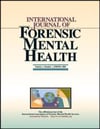
This study examined the utility of an admission screening process to explore whether screening processes can be useful in identifying individuals who have been deemed incompetent to stand trial and may need a comprehensive assessment of feigning. These data confirm that the assessment of response style is a critical component of a forensic evaluation, either at the pretrial stage or upon a defendant’s admission to a facility for competency restoration. This is the bottom line of a recently published article in The International Journal of Forensic Mental Health. Below is a summary of the research and findings as well as a translation of this research into practice.

Featured Article | The International Journal of Forensic Mental Health | 2017, Vol. 16, No. 4, p. 281-292
The Utility of an Admission Screening Procedure for Patients Committed to a State Hospital as Incompetent to Stand Trial
Authors
Barbara E. McDermott, UC Davis
William J. Newman, St. Louis University
Jonathan Meyer, Department of State Hospitals, Sacramento, California
Charles L. Scott, UC Davis
Katherine Warburton, Department of State Hospitals, Sacramento, California
Abstract
Competence to stand trial is the most requested forensic evaluation in the United States, with a minimum of 60,000 assessments conducted per year. In the U.S., once found incompetent, restoration typically is provided by the mental health system, generally via an inpatient admission. There has been a nationwide surge in referrals for competence to stand trial evaluations, with a corresponding increase in defendants court-ordered for restoration. When jurisdictions require inpatient treatment for this restoration process, defendants often wait in jail for a hospital bed. As more states face litigation because of these waiting times, strategies to improve the efficiency of systems charged with restoration is imperative. Our study examined the utility of an admission screening process to achieve this goal. Eight hundred and thirty seven patients were admitted as incompetent to stand trial during the study period, 486 of whom had adequate data for analysis. Our results indicated that this screening process was useful in identifying individuals who may need a comprehensive assessment of feigning. Our data confirm that the assessment of response style is a critical component of a forensic evaluation. If this assessment is not performed pretrial, there is benefit to conducting the assessment on admission for restoration.
Keywords
Malingering, competence to stand trial, competence restoration, admission screening
Summary of the Research
“Feigning of psychiatric symptoms and/or cognitive deficits in order to be found IST is not uncommon…Because of the elevated prevalence rates in criminal forensic evaluations, most authors agree that the assessment of feigning should be a routine part of CST evaluations…This study of archival clinical data provides descriptions of patients admitted as incompetent to stand trial. We also examined if the screening itself or the programmatic changes implemented as a consequence of this screening, specifically performing more extensive evaluations of patients identified as possibly feigning, impacted length of stay for these patients, a proxy for improved efficiency” (p.282-284).
“All IST patients were admitted directly from the referring county jails…Once interviewed and administered the assessment tools, clinicians were required to make judgments about the patients’ overall competence and on both prongs of Dusky (understanding of criminal proceedings and ability to assist in their own defense), potential for feigning of psychiatric symptoms or cognitive/memory deficits, and presence of possible cognitive deficits. These judgments were based on their interview combined with results from the structured assessments… For the majority of the evaluations, the Structured Interview of Reported Symptoms (SIRS) was used to provide a more thorough assessment of response style. On occasion, the Test of Memory Malingering (TOMM) was employed if there was an indication that feigning was primarily of memory deficits” (p. 285-286).
“The primary purpose these data were collected was to provide descriptions to the administration on the base rate of feigning on admission. Secondary questions included (1) did the screening procedure, by itself, impact length of stay and (2) did conducting comprehensive evaluations on patients suspected of feigning decrease length of stay and/or improve the identification of malingering… For the group on whom a more extensive evaluation was conducted, the risk assessment score was significantly higher, scores on the competence screening were significantly lower, and length of stay was significantly shorter. For patients who were more extensively evaluated following the admission screening, 20 of the 32 (93.75%) were confirmed as feigning psychiatric symptoms or cognitive deficits” (p.286-287).
“In general, the two groups identified on the admission screening as possibly feigning (one group confirmed as feigning) scored similarly on the assessments with two exceptions: the competence assessment and the risk assessment. The competence assessment on admission evidenced much lower scores in the patients who were confirmed as feigning, whereas this score did not differ between patients believed to be feigning on admission but not confirmed and patients not believed to be feigning. The risk assessment differed between all three groups. The LOS was significantly shorter in the group confirmed as feigning; the group believed to be feigning but not confirmed did not differ in LOS from the group not believed to be feigning on admission…the label of malingering was significantly more likely to appear in the diagnosis section of the report if the patient was confirmed as feigning with structured assessments. These individuals were also significantly less likely to receive a diagnosis of a psychotic disorder” (p.287-288).
“The rate of suspected feigning in our sample is comparable to rates reported in pretrial evaluations. While the exact explanation for this is unclear, it is likely these rates of feigning post-incompetency finding is due to poor quality of pretrial forensic evaluations…Our data suggest that the assessment of feigning is a critical component of a competence to stand trial evaluation…Our data indicate that even if court evaluators do not consider response style, entities charged with restoration should screen for this on admission as one method for improving system efficiency.” (p.289).
Translating Research into Practice
“These results suggest that an extremely low score on a competence assessment instrument should raise concerns for feigning…employing a structured assessment of feigned lack of knowledge of the criminal justice system, such as the Inventory of Legal Knowledge, in addition to assessments of feigned symptoms when conducting competence to stand trial evaluations…Our data suggest that a medico-legal context by itself is sufficient to trigger a consideration of malingering. In forensic evaluations, an external incentive always exists; with feigning rates reported at 21% or higher in competence valuations, consideration of response styles in these valuations should be the standard of practice. Further, if response style is not assessed in the court ordered evaluation, it should always be evaluated on entrance to a competence restoration treatment program. Our data indicate that a screening procedure is useful in identifying patients who warrant a more comprehensive assessment” (p.289-290).
Other Interesting Tidbits for Researchers and Clinicians
“It is noteworthy that malingering appears more frequently in the diagnostic section of the court report when structured assessments were administered. This is not surprising for two reasons. One is that it is much easier to testify that a defendant is malingering if a structured assessment is available to provide empirical support for that opinion. In fact, increasingly forensic scholars are recommending structured assessments as one component in determining if an individual is feigning symptoms…Second, and perhaps more importantly, for patients who received a more extensive evaluation of response style, the court reports were written by the forensic evaluator…all evaluators had received extensive forensic training or were at the time of their evaluations completing a fellowship in forensic psychiatry. Evidence suggests that training improves the quality and accuracy of evaluations and our data support this conclusion” (p.289).
Join the Discussion
As always, please join the discussion below if you have thoughts or comments to add!






















